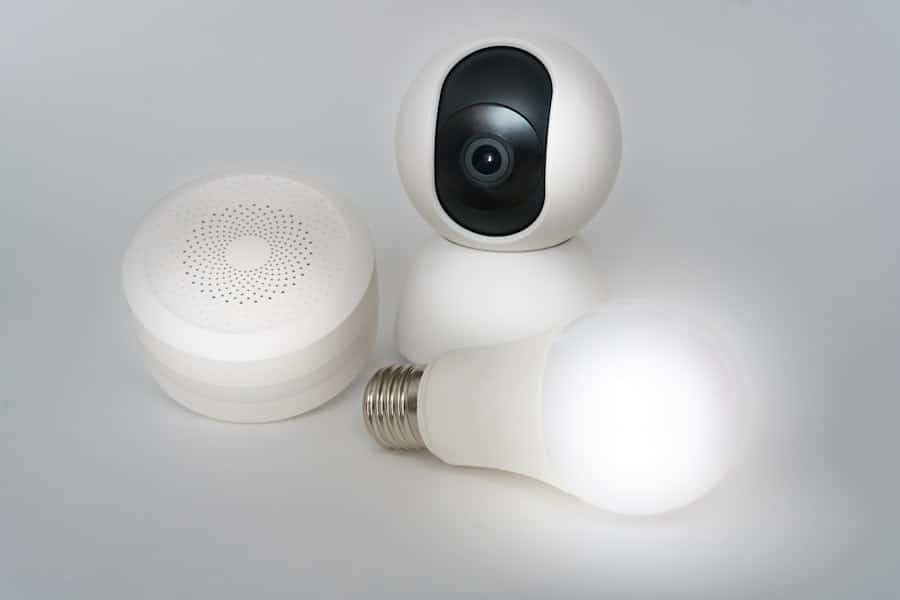The advent of artificial intelligence (AI) has revolutionized numerous sectors, and the realm of smart home devices is no exception. Smart home technology encompasses a wide array of devices designed to enhance the convenience, security, and efficiency of residential living. From smart thermostats that learn user preferences to intelligent security systems that can differentiate between familiar faces and intruders, AI plays a pivotal role in making these devices more intuitive and responsive.
The integration of AI into smart home devices not only streamlines daily tasks but also fosters a more personalized living environment, adapting to the unique needs and habits of each household. As consumers increasingly seek automation and connectivity in their homes, the demand for AI-driven smart home devices continues to grow. This surge is fueled by advancements in machine learning, natural language processing, and sensor technology, which collectively enable devices to learn from user interactions and improve their functionality over time.
The result is a seamless ecosystem where devices communicate with one another, creating a cohesive network that enhances the overall user experience. In this article, we will explore the current state of AI in smart home devices, examine the integration of AI technologies, discuss recent advancements, and consider the potential applications and challenges that lie ahead.
Key Takeaways
- AI in smart home devices is revolutionizing the way we interact with our homes, making them more efficient, convenient, and secure.
- Current AI in smart home devices includes voice assistants, smart thermostats, security cameras, and smart appliances, all designed to make our lives easier.
- Integration of AI with smart home devices allows for seamless automation, personalized experiences, and predictive capabilities.
- Advancements in AI technology for smart home devices include improved natural language processing, machine learning algorithms, and computer vision for enhanced functionality.
- Potential applications of AI in smart home devices range from energy management and health monitoring to entertainment and home security, offering endless possibilities for innovation and improvement.
Current State of AI in Smart Home Devices
Voice-Activated Assistants: The Central Hub of Smart Home Ecosystems
Voice-activated assistants like Amazon’s Alexa, Google Assistant, and Apple’s Siri have become central to many smart home ecosystems. These platforms utilize natural language processing to understand and respond to user commands, allowing for hands-free control of various devices.
Convenience and Efficiency in Everyday Life
For instance, users can adjust lighting, control thermostats, or even manage security systems simply by speaking commands, showcasing the convenience that AI brings to everyday life. Moreover, smart appliances such as refrigerators, washing machines, and ovens are increasingly equipped with AI capabilities.
Intelligent Appliances for a Sustainable Future
These devices can analyze usage patterns and optimize their operations accordingly. For example, a smart refrigerator can track food inventory and suggest recipes based on available ingredients, while a washing machine can determine the optimal wash cycle based on load size and fabric type. This level of intelligence not only enhances efficiency but also contributes to energy savings, aligning with the growing emphasis on sustainability in modern households.
Integration of AI with Smart Home Devices

The integration of AI with smart home devices is a multifaceted process that involves both hardware and software components working in harmony. At the core of this integration are IoT (Internet of Things) technologies that enable devices to connect to the internet and communicate with each other. This connectivity allows for real-time data exchange, which is essential for AI algorithms to function effectively.
For instance, a smart thermostat can gather data from various sensors throughout the home to learn about temperature preferences and occupancy patterns, adjusting heating or cooling settings accordingly. Furthermore, the integration of AI extends beyond individual devices to encompass entire ecosystems. Smart home platforms like Google Home or Apple HomeKit serve as central hubs that facilitate communication between disparate devices.
This interconnectedness allows for complex automation scenarios; for example, a user can set up a routine where lights dim and the thermostat adjusts when they arrive home from work. Such automation not only enhances convenience but also creates a more cohesive living environment where devices work together seamlessly.
Advancements in AI Technology for Smart Home Devices
Recent advancements in AI technology have significantly enhanced the capabilities of smart home devices. Machine learning algorithms have become more sophisticated, enabling devices to learn from user behavior with greater accuracy.
This adaptability ensures that energy consumption is optimized without sacrificing comfort. Additionally, computer vision technology has made significant strides, particularly in security applications. Smart cameras equipped with AI can analyze video feeds in real-time to detect unusual activities or recognize familiar faces.
This capability enhances security by reducing false alarms and providing users with actionable insights about their home environment. For example, if a camera identifies an unknown individual approaching the front door, it can send an alert to the homeowner’s smartphone, allowing them to take appropriate action.
Potential Applications of AI in Smart Home Devices
The potential applications of AI in smart home devices are vast and varied, extending well beyond basic automation. One promising area is energy management; AI can analyze energy consumption patterns and suggest ways to reduce waste. For instance, smart plugs can monitor the energy usage of connected devices and provide insights into which appliances consume the most power.
By leveraging this data, homeowners can make informed decisions about their energy consumption habits. Another significant application lies in health monitoring and wellness. Smart home devices equipped with AI can track various health metrics, such as sleep patterns or air quality levels.
For example, smart beds can analyze sleep quality and provide recommendations for improving rest based on user data. Similarly, air quality monitors can detect pollutants or allergens in the home environment and suggest actions to improve indoor air quality. These applications not only enhance comfort but also contribute to overall well-being.
Challenges and Limitations of AI in Smart Home Devices

Despite the numerous benefits associated with AI in smart home devices, several challenges and limitations persist. One major concern is data privacy and security. As these devices collect vast amounts of personal data to function effectively, there is an inherent risk of data breaches or unauthorized access.
Consumers may be hesitant to adopt smart home technology if they perceive that their privacy is at risk. Manufacturers must prioritize robust security measures and transparent data handling practices to build consumer trust. Another challenge lies in interoperability among different devices and platforms.
The smart home market is fragmented, with numerous manufacturers producing devices that may not communicate effectively with one another. This lack of standardization can lead to compatibility issues, frustrating users who expect a seamless experience. Efforts are underway to establish common protocols and standards that would facilitate better integration across various devices and ecosystems.
Future Trends and Predictions for AI in Smart Home Devices
Looking ahead, several trends are poised to shape the future of AI in smart home devices. One notable trend is the increasing emphasis on personalization. As AI algorithms become more advanced, they will be able to tailor experiences based on individual preferences and behaviors more effectively than ever before.
This could manifest in smarter recommendations for energy usage or personalized entertainment options based on viewing habits. Additionally, the rise of edge computing is likely to play a significant role in the evolution of smart home technology.
This shift will enable real-time decision-making for critical applications such as security monitoring or health tracking, further enhancing the functionality of smart home devices.
The Impact of AI on the Future of Smart Home Devices
The impact of AI on the future of smart home devices is profound and far-reaching. As technology continues to evolve, we can expect smarter, more intuitive devices that not only enhance convenience but also contribute positively to our quality of life. The integration of AI will enable homes to become more responsive environments that adapt to our needs while promoting sustainability and well-being.
As we navigate this exciting landscape, it is essential for manufacturers to address challenges related to privacy and interoperability while continuing to innovate and push the boundaries of what is possible with AI in smart homes. The future holds immense potential for creating living spaces that are not only smarter but also more attuned to our lifestyles and preferences, ultimately transforming how we interact with our homes on a daily basis.
AI in Smart Home Devices – What’s Next? As we continue to see advancements in artificial intelligence, the possibilities for smart home devices are endless. One related article that delves into the future of AI is Tesla Refutes Elon Musk’s Timeline on Full Self-Driving. This article discusses the challenges and setbacks in achieving fully autonomous vehicles, which could also impact the development of AI in smart home devices. It is important to stay informed on the latest trends and technologies, such as the ones highlighted in Top Trends on Digital Marketing 2023, to understand how AI will continue to shape our daily lives.
FAQs
What is AI in smart home devices?
AI in smart home devices refers to the integration of artificial intelligence technology into household appliances and systems to automate and optimize various tasks and functions. This can include voice recognition, predictive maintenance, energy management, and personalized user experiences.
What are some examples of AI in smart home devices?
Examples of AI in smart home devices include smart thermostats that learn and adapt to the user’s preferences, voice-activated virtual assistants like Amazon Alexa and Google Assistant, security cameras with facial recognition, and smart appliances that can be controlled remotely and learn usage patterns.
How does AI benefit smart home devices?
AI benefits smart home devices by enabling them to learn and adapt to user behavior, automate routine tasks, optimize energy usage, enhance security features, and provide personalized experiences. This can lead to increased convenience, energy savings, and improved overall functionality.
What are the potential future developments for AI in smart home devices?
Potential future developments for AI in smart home devices include improved natural language processing for virtual assistants, enhanced predictive analytics for energy management, integration with wearable devices for seamless user experiences, and advancements in machine learning for more personalized and adaptive automation.

